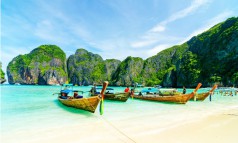



















Sunday, Dec 31, 2023 08:30 [IST]
Last Update: Sunday, Dec 31, 2023 02:54 [IST]
Gautama Buddha's parents were from two different Mahajanapadas (kingdoms) of the Suryavanshi Dynasty. His father King Suddhodana belonged to the Shakya kingdom, and his mother Queen Maya was from the Kolya kingdom. Buddha was married to Yasodhara, the daughter of Koliya’s King Suppabuddha, who was maternal uncle of Buddha. One-eighth portion of remains of Buddha is kept in a stupa located at Ramagram, the capital of Koliya state. Ramagram is under the jurisdiction of the Lumbini Province of Nepal.
According to Buddhist scriptures, after Buddha's Nirvana, his cremated remains were distributed among eight princes of the 16 Mahajanapads. Each prince built a stupa in or near his capital and buried his ashes there.According to the Mah?parinibb??a Sutta, the Buddha's remains were cremated in Kushinagar after his Parinirvana. Initially, it was believed that only to the Shakya clan of Kapilvastu would be the claimants of Buddha’s relics. However, six other clans and one king claimed the Buddha's remains. To settle this dispute, a Brahmin named Drona divided the Buddha's ashes into eight portions.
Those who received equal portions Buddha’s remains were as follows:
1. Ajatshatru, the King of Magadha;
2. The Licchavis of Ves?li;
3. The Sakyas of Kapilavastu;
4. The Bulis of Allakappa;
5. The Koliyas of Ramgrama;
6. The Brahmin of Ve?had?pa;
7. The Mallas of P?v?; and
8. The Mallas of Kusinagar
After converting himself a Buddhist, Emperor Ashoka believed that Buddhism was beneficial for all people, not just plants and animals, and established 84,000 stupas, Sangharama’s, Viharas, Chaityas, and residences for Buddhist monks throughout South and Central Asia.
Years later, when Ashoka began collecting all the Buddha's relics to redistribute and re-enshrine in his 84,000 stupas, it took no time at all to collect his share of the first seven Drona stupas. Without any difficulty, we then reached the Naga king's palace at Ramagrama. The Nagas refused to hand over the relics to Ashoka because they want to continue worshiping their share of the relics. Ashoka, realizing that he might not surpass the dedication and sacrifice of the Nagas, agrees, and leaves empty-handed.
According to Ashokavadhana, a narrative about Emperor Ashoka, he redistributed the collected relics and enshrined them in his 84,000 stupas built throughout Jambudvipa. This became Ashoka's most famous and legendary act, and for centuries pilgrims visiting India's holy sites have attributed nearly every ancient stupa they encountered to Ashoka. The Ashokavadhana version has it: “Then Ashoka had 84,000 chests made of gold, silver, cat’s eye, and crystal; Relics were kept there. In addition, 84,000 urns and 84,000 inscriptions were prepared. All this was given to the Yaksha and distributed among the 84,000 stupas he built in large, medium, and small cities with a population of 100,000 people all over the earth down to the surrounding oceans."
The Buddha's relic in Ramagrama (also known as Ramagram) is one of the ancient and significant relics associated with Gautama Buddha, the founder of Buddhism. According to Buddhist tradition, after the Buddha's death (parinirvana), his cremated remains were divided among his followers, and the relics were enshrined in various stupas or relic monuments.
Ramagrama is one of the eight great stupas that house the Buddha's relics. The other seven are in different places, such as Kapilavastu, Vaishali, Allakappa, Kushinagar, Pava, Bhikshekuthan, and Vethadipa. Each of these stupas is believed to contain one portion of the Buddha's relics.
Ramagrama is particularly associated with the Buddha's right lower scapula bone. The relic was discovered in the early 20th century during archaeological excavations in a mound in the village of Niglihawa in the Nawalparasi District of Nepal. The relic was found in a small container made of soapstone.
The discovery of the relic at Ramagrama added to the historical and religious significance of the site. Pilgrims and Buddhists consider these relics as sacred objects symbolizing the Buddha's enlightenment and teachings. The stupas containing these relics are revered pilgrimage sites, and people from around the world visit them to pay their respects and gain spiritual merit.
Archaeologists discovered relics from the Buddha era during excavations at the Ramgram stupa in western Nawalparasi. Excavations at this historic site uncovered a pond and a vihar structure (monastery) believed to have been built during the time of the Buddha (circa 5th century BC). Excavations had uncovered some of the bricks used to build the Bihar (Monastery) and the pond. Experts claim that the discovery of relics from the Ramgram Stupa is one of his eight original stupas that housed the remains of Buddha Sakyamuni. The stupa is located on a brick hill in District 7 of Ramgram Municipality, about 7 km south of Parasi, the district headquarters of western Nawalparasi. According to residents, the historic site has been neglected as no proper efforts were made to preserve it. Despite its historical significance, residents complain that the area is being overshadowed by authorities who have not prioritized excavation, exploration, and research and development in the area. Residents of Ramgram in Nawalparasi are demanding more excavations in the area following recent discoveries. They claim that this area was once the capital of the ancient Koliya state.
In 2014, a team of archaeologists discovered extensive evidence that Panditpur, located in the then Banjariya VDC, was the capital of the ancient Koliya state. The research team claimed that the material they discovered dates to the 7th century BC. B.C. During BC excavations, well mouths, topaz, bangles, crystals, stones, and human figures from the Kushan period (circa 2nd century BC to 1st century AD) were discovered.
Buddhist period is important evidence that the Ramgram area is a place of historical and archaeological importance worthy of being included in the UNESCO World Heritage List. Nepali authorities are working to add Ramgram Stupa to UNESCO's World Heritage List since the year 1996.
he author is a Communication Expert. Email: vidhukayastha@gmail.com)
